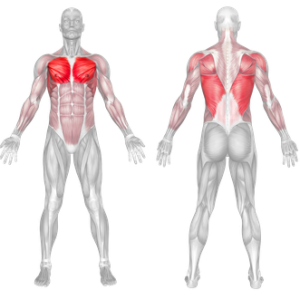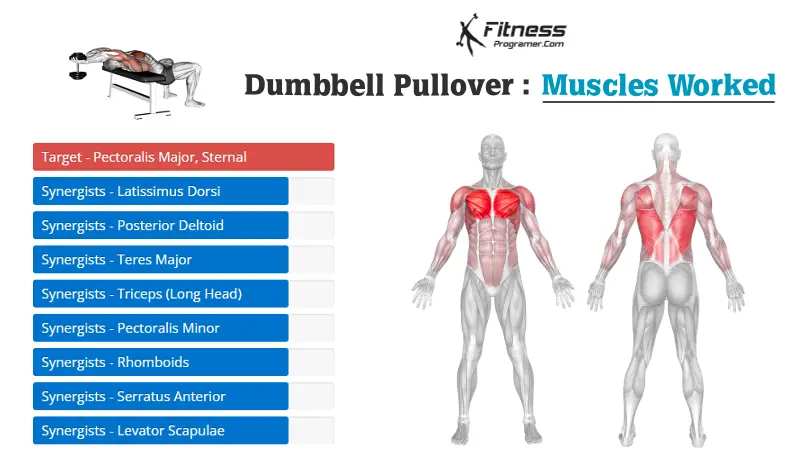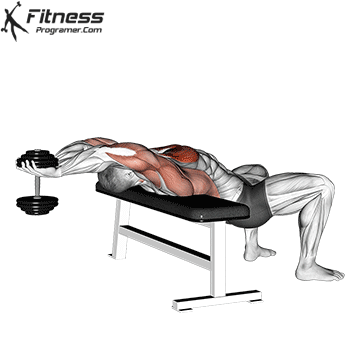Overview
The dumbbell pullover is a strength training exercise that targets the muscles of the upper body, including the chest, back, and shoulders. It involves lying on a flat bench while holding a dumbbell with both hands above your chest, then extending it back behind your head.
Depending on arm angle and muscle intent, it can emphasize the pectoralis major or the latissimus dorsi. The movement challenges shoulder flexion, core stabilization, and upper back control. It’s also an excellent move for improving shoulder mobility and posture when done with control.
How to Perform Dumbbell Pullover
Set Up: Lie on a flat bench with only your upper back and shoulders supported. Keep your feet flat on the ground.
Grip the Dumbbell: Hold one dumbbell with both hands under the inner plate, arms extended above your chest.
Brace and Lower: Inhale, brace your core, and slowly arc the dumbbell back and down behind your head. Maintain a slight bend in the elbows.
Stretch and Return: Once you feel a stretch in your lats and chest, reverse the motion by pulling the dumbbell back over your chest using your lats or chest.
Finish Controlled: Exhale at the top and repeat for desired reps with smooth, controlled movement.
Tips for Proper Form
Keep the elbows slightly bent throughout to reduce joint strain.
Lower the dumbbell only as far as you can control without hyperextending your spine.
Drive through your lats or chest on the return—don’t just swing the weight back.
Keep your ribcage down if you want more lat activation; allow a slight arch for chest focus.
Start light to learn the correct path and shoulder control.
Common Mistakes
Overarching the lower back, which shifts tension away from target muscles.
Using too heavy a weight and letting momentum do the work.
Bending the elbows too much, turning it into a triceps extension.
Incomplete range of motion, especially in the stretch phase.
Losing grip control—always secure the dumbbell with both hands firmly.
Benefits of Dumbbell Pullover

- Builds Chest and Back Together: A rare movement that activates both the pecs and lats, promoting upper body mass and balance. By engaging multiple muscle groups at once, you can increase your overall strength and muscle mass.
- Enhances Ribcage Expansion: Used by classic bodybuilders to increase thoracic cavity size and improve breathing mechanics.
- Improves Shoulder Mobility: Encourages controlled shoulder flexion and overhead reach while engaging stabilizing musculature.
- Adds Variety to Chest or Back Workouts: Functions as a chest isolation, lat-focused, or hybrid accessory depending on setup and intent.
- Better Posture and Mobility: Dumbbell pullover is considered a postural exercise by sports physiologists and researchers. This can help to improve your posture and reduce the risk of shoulder injuries.
- Increases Mind-Muscle Connection: Slower tempo and deep range allow focus on controlled stretch and contraction phases.
How to Incorporate Into Your Routine
Hypertrophy: 3–4 sets of 8–12 reps (moderate to heavy weight)
Endurance: 3–4 sets of 12–15 reps (lighter weight)
Mobility/Flexibility: 3 sets of 10–12 reps (very light, controlled)
For Functional Fitness: Use as a mobility-builder and muscle activator in low-load warm-ups.
In Rehab/Corrective Work: Use light dumbbells and short ranges to promote shoulder control.
Dumbbell Pullover Muscles Worked

Frequently Asked Questions
Is this a chest or back exercise?
It can be either, depending on arm angle and intent. Flared elbows and rib expansion hit the pecs; tucked arms and flat back hit the lats more.
Should I go heavy or light?
Use moderate weight to maintain form and full range. Going too heavy often leads to compensations and limited stretch.
Is it bad for shoulders?
Not if performed with control and a limited range based on your mobility. Start light and avoid extreme positions.
Can beginners do this?
Yes, with light weights and a focus on slow, smooth movement. It’s a great tool to build upper body awareness.
Can I do this on the floor?
Yes, a floor version limits range of motion but can be a safe and effective alternative for beginners or those with shoulder limitations.


